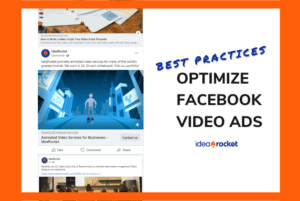You’ve been tasked with managing a video project. You need to communicate strategic information to the creative team that will make the video. How will you do it? With a Video Creative Brief.
Of course, your video-makers may have their own preferred method of extracting the information they need. At IdeaRocket, we prefer an in-depth interview, because it allows for some serendipity. Many other studios use a questionnaire. But either way, it might be useful for you to gather the information beforehand, especially if it requires consultation with a broader set of stakeholders.
Before jumping into what goes into a creative brief, an important point to make about it is that it should be brief! If it is longer than 2 pages, it will not be as effective in kicking off the creative process.
What Is the Objective of the Video?
We wrote at some length last week about the need to define an objective for your video. Your video objective should:
- Be specific
- Connected to broader goals
- Measured by a metric
- With time and performance targets.
Who Is The Audience?
In real life you wouldn’t address a 7-year-old the same way you would address your college professor. When you are making a video, who you are addressing is also important.
Specify these demographic factors for your audience:
- Age
- Gender
- Income
- Education
- Race/ethnicity
- Nationality
And if it is a B2B buying situation, include these organizational factors:
- Job title
- Place in decision-making process or hierarchy
Finally, go a step further and consider psychographics. Are there character traits (extroversion, curiosity, sensitivity, for example) that your audience shares? A group of yoga teachers are going to be very different psychologically than a group of stockbrokers.
What Is The Brand?
Arming your animation providers with information about your brand will allow them to create a video that will seamlessly integrate with your total brand experience. Here are some questions to answer:
- How does your brand express itself? Is it casual or buttoned-up? Funny and light, or serious and professional? What do you value as an organization? What do you hate?
- What is your brand promise? What can your customers expect from you?
- What is your visual identity? Many companies have brand books that codify their visual identity, specifying typefaces, color palettes, and graphic design rules for creating marketing collateral. Include it with your Brief, or if you don’t have one, specify these choices in the Brief.
Finally, define how important is it to express this brand as part of the video. Sometimes, companies have a good reasons to not brand a video strongly, or to leave their brand out of it all together.
How Will The Video Be Distributed?
It’s imperative that you define how the video will be distributed, because this can affect how it is made and delivered.
- Home page videos/email videos: These generally work best when they are shorter.
- Trade show booth videos: These have to capture attention and communicate what your company does very quickly; also, sound is likely to be lost, so don’t rely on a voiceover for messaging.
- Event videos: There is less time pressure on these, because it’s a captive audience. However, you don’t want to kill the vibe of the event; excitement is essential. Also, a large delivery format is sometimes indicated.
- Broadcast commercials: These are limited to 0:15, 0:30, or 0:60 second blocks. Some outlets will have broadcast standards that need to be followed.
- Social media: Many of these are played without sound, so containing the message in text is often wise. Instagram videos are limited to one minute or less.
Often a video will receive more than one type of usage; if so, indicate which are the more important ones.
What Is The Message?
Finally, you also need to say what you message is.
If it is a marketing video, you should answer these questions about your product or service:
- What is the pain point the product addresses? How do your buyers experience that problem?
- What are the features?
- What are the benefits? (Both emotional and practical.)
- What are the differentiators with your competition? Who is the competition?
- Is there an action you would like your prospects to take after they see the video?
- Is there anything that absolutely must be included in the video? Anything that must not be included?
If it is an employee-facing video, you should ask these questions:
- What do you want your employees to learn and why?
- Do you want employee behavior to change? If so, how?
- Will this video be used to meet compliance requirements? If so, what are the must-haves?
- What is the company culture you are trying to build?
If you are running an awareness campaign, rarely do these not have a behavioral aspect to them – specify how you want your viewer’s behavior to change.
What Is The Style?
Do you have a style or approach you would prefer for the video? Include some links to examples of video styles that you feel would serve you well. These are the style categories that are available:
- Motion graphics (little or no character animation)
- Traditional 2d animation
- Puppet-style 2d animation
- 3d animation
- Whiteboard animation
- Stop-motion
Note that there is some overlap between these. A lot of motion graphics use 3d animation, for instance, and there are hybrid style that combine techniques.
How Long Should The Video Be?
We’ve already talked a little about how usage affects length. On websites, research has shown that viewership falls the longer a video gets.

It’s important to realize exactly why that’s happening. It’s not just because people play the video and get bored, although that also happens. It’s mainly because people look at the play-bar, see how much time is left on the video, and then they ask themselves: “is this video worth x minutes of my time?” The longer the video, the likelier they are to say no. Research shows that drop-offs start right away, but after two minutes, you are seriously limiting the size of your audience.
At the same time, you have certain information that you need to pass on. At this stage, it’s good to ask yourself: exactly how much information does your viewer need? If it’s a marketing video, for instance, your prospect is not going to need to know everything about your product to take the next step in the sales process (whether that be submitting their email address, asking for a live demo, starting a free trial, or something else.) So how much does she need to know to persuade her to take the next step?
Weigh the amount of information you need to achieve your objective with the benefits of brevity, and you will net out at the right length for your video. State that length in the Creative Brief.
Your Creative Brief is your marching orders for your creative team. It gives them direction, and the best chance to succeed on your behalf.
This post forms a chapter from my ebook, Succeeding With Animated Video. To read the rest of my advice on how to manage an animated video production for your organization, sign up for our newsletter below and you will receive the ebook for free.




